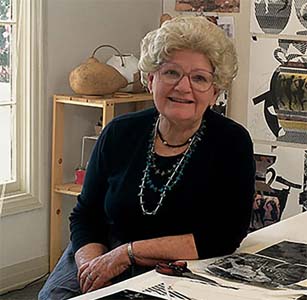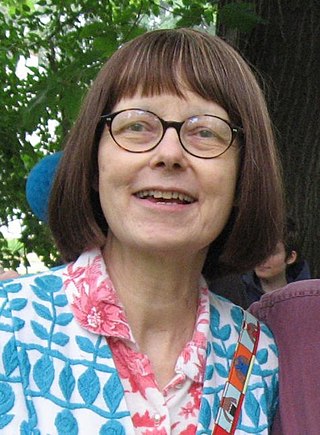This article needs additional citations for verification .(February 2011) |
Bonnie Hale Leman was the founder of Quilter's Newsletter Magazine, and one of the nation's first female magazine publishers.
This article needs additional citations for verification .(February 2011) |
Bonnie Hale Leman was the founder of Quilter's Newsletter Magazine, and one of the nation's first female magazine publishers.
Born September 28, 1926, in Purdin, Missouri, to Rex and Laura Hale, she left home for college at age 16. She graduated from Park College three years later. She moved to Denver in 1953 and she met her husband, George Leman, while they were both pursuing master's degrees at the University of Denver.
A mother, teacher and freelance writer, Leman found her calling in the publishing business in 1969 when she founded "Quilter's Newsletter Magazine".
Through the magazine, she helped revive and foster an appreciation of quilts as a great American art form that continues to this day. The publication garnered international praise and guided the revival of an iconic American art. Leman grew her magazine readership to more than 200,000 subscribers in more than 100 countries, as well as writing and publishing numerous books and other publications on quilt making. She traveled much of the world in the course of her career, and contributed to the growth of the quilt making art in many countries. She finally decided to retire in 1995.

Quilting is the term given to the process of joining a minimum of three layers of fabric together either through stitching manually using a needle and thread, or mechanically with a sewing machine or specialised longarm quilting system. An array of stitches is passed through all layers of the fabric to create a three-dimensional padded surface. The three layers are typically referred to as the top fabric or quilt top, batting or insulating material, and the backing.

Sarah Josepha Buell Hale was an American writer, activist, and editor of the most widely circulated magazine in the period before the Civil War, Godey's Lady's Book. She was the author of the nursery rhyme "Mary Had a Little Lamb". Hale famously campaigned for the creation of the American holiday known as Thanksgiving, and for the completion of the Bunker Hill Monument.

African-American art is a broad term describing visual art created by African Americans. The range of art they have created, and are continuing to create, over more than two centuries is as varied as the artists themselves. Some have drawn on cultural traditions in Africa, and other parts of the world, for inspiration. Others have found inspiration in traditional African-American plastic art forms, including basket weaving, pottery, quilting, woodcarving and painting, all of which are sometimes classified as "handicrafts" or "folk art".
Marie Daugherty Webster was a quilt designer, quilt producer, and businesswoman, as well as a lecturer and author of Quilts, Their Story, and How to Make Them (1915), the first American book about the history of quilting, reprinted many times since. She also ran the Practical Patchwork Company, a quilt pattern-making business from her home in Wabash, Indiana, for more than thirty years. Webster's appliquéd quilts influenced modern quilting designs of the early twentieth century. Her quilts have been featured in museums and gallery exhibition in the United States and Japan. The Indianapolis Museum of Art holds the largest collection of her quilts in the United States. Webster was inducted into the Quilters Hall of Fame in 1991. The Marie Webster House, her former residence in Marion, Indiana, was listed on the National Register of Historic Places in 1992, was designated a National Historic Landmark in 1993, and serves as the present-day home of the Quilters Hall of Fame.
Quilt art, sometimes known as art quilting, mixed media art quilts or fiber art quilts, is an art form that uses both modern and traditional quilting techniques to create art objects. Practitioners of quilt art create it based on their experiences, imagery, and ideas, rather than traditional patterns. Quilt art generally has more in common with the fine arts than it does with traditional quilting. Quilt art is typically hung or mounted.
Cuesta Benberry was an American historian and scholar. Considered to be one of the pioneers of research on quiltmaking in America, she was the pioneer of research on African-American quiltmaking. Her involvement in quilt research spans from founding and participating in various quilt groups to writing articles in renowned quilt magazines and journals. As a quilt scholar, Benberry acquired a collection of important quilts dating from the late 19th century up to the 21st century, as well as an extensive collection of paper documents supplementing quilting exhibitions, books, articles and her personal research.
The Quilt Treasures Project is an oral history project that documents the stories of a number of notable individuals who were instrumental in moving the 20th Century Quilt Revival forward in some significant way. These individuals include:
Michael Francis James is an American artist, educator, author, and lecturer. He is best known as a leader of the art quilt movement that began in the 1970s. He currently lives and maintains a studio in Lincoln, Nebraska.

Katherine Westphal was an American textile designer and fiber artist who helped to establish quilting as a fine art form.
Women of Color Quilters Network (WCQN) is a national organization dedicated to preserving African American quiltmaking.

Mary Catherine Lamb was an American textile artist, whose quilts reframed traditional Roman Catholic iconography. Recycling vintage textiles popular during the mid-20th Century, she both honored and affectionately skewered her Catholic upbringing.
Therese May is an American artist who was an early participants in the art quilt movement that began in the 1960s. She is known for her mixed media quilts and is featured in several contemporary quilting histories.

Jean Ray Laury was an American artist and designer. She was one of the first fine artists to move to quilting as a medium of choice in the late 1950s. Her quilts followed neither traditional method nor pattern; they were bold, modern, colorful collages, often laced with humor and satire. Penning over twenty books and teaching over 2,000 workshops, Laury helped women see the creative possibilities in everyday objects and awake their sense of inspiration. Laury has been called a "foremother of a quilt revival", and "one of the pioneers" of non-traditional quilts.
Martha Neill Upton was a watercolorist, sculptor and studio quilt artist. Her quilted tapestries helped quilts become seen as fine art, rather than craft work, during the early 1970s. Her quilts were shown in the first major museum exhibition of non-traditional quilts, The New American Quilt at New York's Museum of Arts and Design, then called the Museum of Contemporary Craft, in 1976.
Louisiana Bendolph is an American visual artist and quilt maker. Bendolph is associated with The Quilts of Gee's Bend and her work has been considered more conceptual because of her use of vibrant color.

Lucy Marie (Young) Mingo is an American quilt maker and member of the Gee's Bend Collective from Gee's Bend (Boykin), Alabama. She was an early member of the Freedom Quilting Bee, which was an alternative economic organization created in 1966 to raise the socio-economic status of African-American communities in Alabama. She was also among the group of citizens who accompanied Martin Luther King Jr. on his 1965 march from Selma to Montgomery, Alabama.

Sandra Sider is an American quilt artist, author, and curator. She holds a PhD in comparative literature from University of North Carolina, Chapel Hill, specializing in Renaissance studies. She also holds an M.A. in art history from the New York University Institute of Fine Arts.
Susan Hoffman (b.) is a quilt artist. She began quilting while still in high school, and with her friend and fellow quilt artist Molly Upton, opened a small shop to sell artwork in her hometown in Vermont. Hoffman attended college at the University of Denver.
Alvia J. Wardlaw is an American art scholar, and one of the country's top experts on African-American art. She is Curator and Director of the University Museum at Texas Southern University, an institution central to the development of art by African Americans in Houston. She also is a professor of Art History at Texas Southern University. Wardlaw is a member of the Scholarly Advisory Council of the National Museum of African American History and Culture, and co-founded the National Alliance of African and African American Art Support groups in 1998. Wardlaw was University of Texas at Austin's first African-American PhD in Art History.
Geraldine Elizabeth Kahle Beyer is an American quilt designer, quilter, author, teacher and lecturer. Considered by the quilting industry and the publishing media to be of the first designers to form a fabric collection suited to the needs of quilters, she began her career in India after she had run out of yarn. Beyer's works have won awards in the print media, and she has written about the history of quilting and her techniques. She has designed collections for fabric companies, and has taught and lectured on the subject domestically and internationally. Beyer was inducted into the Quilters Hall of Fame in 1984.